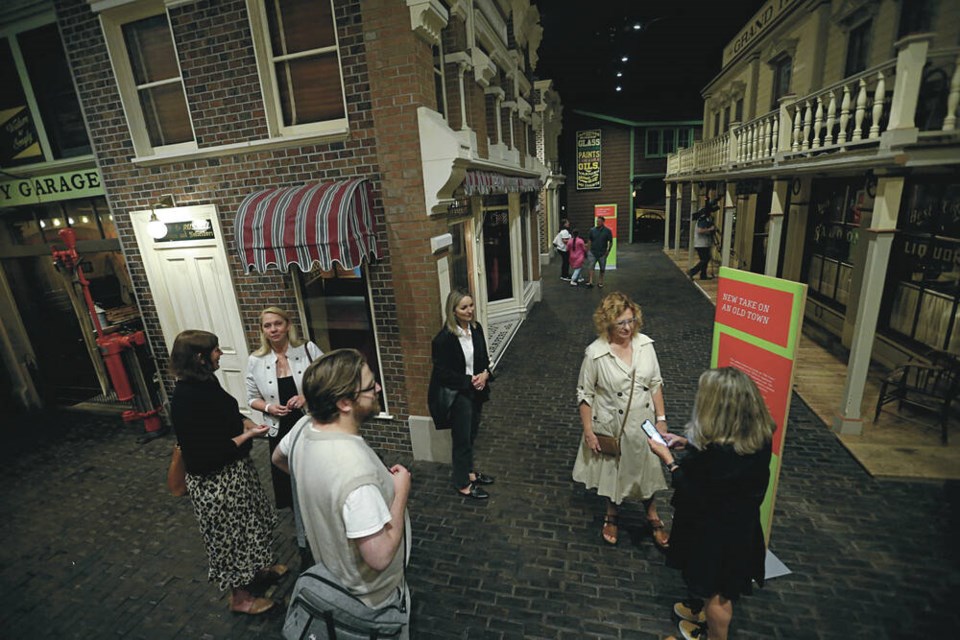The popular Royal B.C. Museum Old Town exhibit reopened on Saturday after being closed for about 18 months, with updated signs and smaller, reworked exhibition space.
“Once it became clear that the new building wasn’t happening, we had to pivot and think about what can we do with the spaces that we have,” said Jana Stefan, the museum’s exhibition production manager.
There has been a huge appetite from the public to see Old Town again, she said.
Some of the subtler exhibit details remain in place, such as the sounds of trains chugging along in the train station and the faint smell of pie near the kitchen, which Stefan said is created through an essential-oil mix that features clove and cinnamon, with a dash of pumpkin spice thrown in “for good luck.”
The Chinatown exhibit has been relighted, with a once-shut door serving as a secondary entrance.
But a number of display areas are empty, in the process of being constructed, or have been closed off to the public.
Regular museum-goers Loraine and Lee Ferreira were busy Saturday morning trying to “spot the difference” in the exhibition. “It’s nice to see some of the stuff that hasn’t changed,” Lee said. “It was nice to see that Chinatown’s still here.”
Loraine said that she liked how some of the signs put old exhibitions in a new context. She pointed to the new sign at an office that described the colonial approaches of land and resource extraction. “It helps you to think of things a little differently,” she said.
While most of the materials inside Old Town remain, around 15 per cent of items previously on display are in storage — mostly material compromised by time or were found to have pest infestations, she said.
The remainder has been re-contextualized with new information panels.
The train station now has panels telling the story of Black porters and Hogan’s Alley, a historic Black settlement in Vancouver.
Joshua T. Robertson, an activist, museum guest curator, and co-founder of the Hogan’s Alley Society, said that those panels, which he helped create, are a great example of the kind of programming and stories that could flourish in Old Town.
The sleeping car porters in Vancouver were elemental to Canada’s federation and have a rich, under-explored history, he said. “A lot of our history is not shown in these spaces.”
Chris O’Connor, the museum’s director of community engagement, said the plan is to have empty spaces in the exhibit show more programming like Robertson’s. “It’s [about] creating space for that important conversation and expression of community voices.”
B.C. Tourism Minister Lana Popham, who attended the opening, called the refreshed space both “a great improvement” and “a work in progress.” She joked that she is the “Minister of Tourism, Arts, Culture, Sport, and Old Town.”
She told the Times Colonist that the exhibit was identified as a file “that needed some work” when she took on the ministerial role in December.
“I don’t think what we see here at Old Town is ever going to be static again,” she said. “I think it’s always going to be evolving.”
Popham acknowledged the museum’s ups and downs in recent years.
The Old Town exhibit included a 2021 message from former museum board chair Daniel Muzyka acknowledging its colonial history and an apology to museum staff members.
The museum’s third-floor galleries were closed late that year to “decolonize” exhibits.
In 2022, then-premier John Horgan said the museum would be closed for eight years while a new building was constructed at a cost of $789 million, triggering a public outcry about the cost and long-closing that ultimately saw that plan cancelled.
About 75 per cent of exhibition space on the third floor remains closed, but some will be re-opened soon, starting with the HMS Discovery ship replica in early 2024.
The First Peoples gallery, which is currently being used for discussion and collaboration with Indigenous communities, is not expected to reopen in the immediate future.
Museum vice-president of strategic operations and incoming acting CEO Tracey Drake said that Old Town’s re-opening is expected to bring more visitors to the museum, which self-generates half of its operating budget from ticket sales for the museum and its Imax theatre.
The museum, which had previously attracted upwards of 880,000 visitors annually, has received 250,000 visitors this year, she said.
“Old Town means a lot, to a lot of people,” she said. “I know that when we first closed, there was a lot of discussion about Old Town, about us erasing our community history.”
“As you can see, it was never about erasure. It was about inclusion. It was about expanding the narratives.”
>>> To comment on this article, write a letter to the editor: [email protected]



